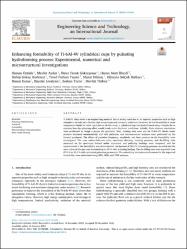Enhancing formability of Ti-6Al-4V cylindrical cups by pulsating hydroforming process: Experimental, numerical and microstructural investigations

Göster/
Erişim
info:eu-repo/semantics/openAccesshttp://creativecommons.org/licenses/by-nc-nd/3.0/us/Tarih
2024Yazar
Öztürk, OsmanAydın, Mevlüt
Gökçepınar, Ömer Faruk
İlbeyli, Harun Mert
Korkmaz, Habip Gökay
Yapan, Yusuf Furkan
Dilmeç, Murat
Halkacı, Hüseyin Selçuk
Üst veri
Tüm öğe kaydını gösterÖzet
Ti-6Al-4V alloy sheet is an engineering material that is widely used due to its superior properties such as high strength-to-density ratio besides high temperature and corrosion resistance. However, its low formability at room temperature limits its wider applications. In this study, a cylindrical cup was hydroformed using a female die to examine how the pulsating effect would result under frictional conditions. Initially, finite element simulations were performed to design a proper die geometry. Next, forming tests were run on Ti-6Al-4V blanks under pressure increased monotonically and with pulsation, and microstructural analyses were performed on the formed specimens. The effects of pulsation frequency, amplitude, and base pressure on the formability were investigated. The nose radius/thickness ratio, maximum thinning, bursting pressure, and die-filling ratio measured on the specimens formed under monotonic and pulsating loadings were compared, and the improvement in the formability was demonstrated. An increase of 38.5 % in bursting pressure occurred and the nose radius of the part was decreased up to 30 % with pulsating loading. The die-filling ratio was improved from 87.9 % to 95.3 % with optimized pulsation parameters. The underlying microstructural reasons for the improved formability were elaborated using XRD, SEM, and TEM analyses.
Kaynak
Engineering Science and Technology an International Journal - JESTECHCilt
50Sayı
JanuaryKoleksiyonlar
Aşağıdaki lisans dosyası bu öğe ile ilişkilidir:


















